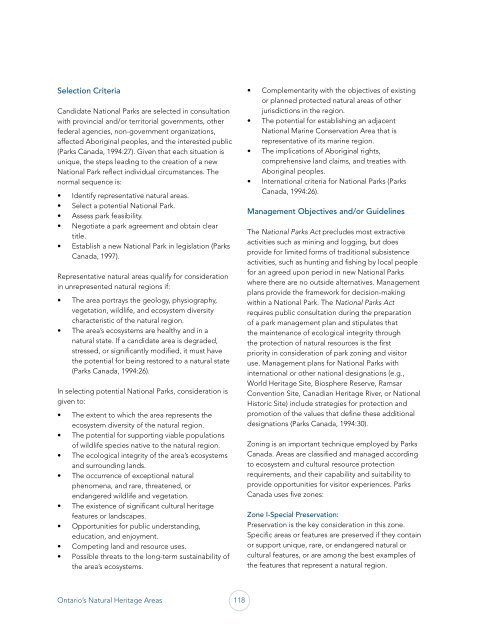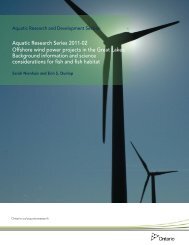Ontario's Natural Heritage Areas - Ministry of Natural Resources
Ontario's Natural Heritage Areas - Ministry of Natural Resources
Ontario's Natural Heritage Areas - Ministry of Natural Resources
Create successful ePaper yourself
Turn your PDF publications into a flip-book with our unique Google optimized e-Paper software.
Selection Criteria<br />
Candidate National Parks are selected in consultation<br />
with provincial and/or territorial governments, other<br />
federal agencies, non-government organizations,<br />
affected Aboriginal peoples, and the interested public<br />
(Parks Canada, 1994:27). Given that each situation is<br />
unique, the steps leading to the creation <strong>of</strong> a new<br />
National Park reflect individual circumstances. The<br />
normal sequence is:<br />
• Identify representative natural areas.<br />
• Select a potential National Park.<br />
• Assess park feasibility.<br />
• Negotiate a park agreement and obtain clear<br />
title.<br />
• Establish a new National Park in legislation (Parks<br />
Canada, 1997).<br />
Representative natural areas qualify for consideration<br />
in unrepresented natural regions if:<br />
• The area portrays the geology, physiography,<br />
vegetation, wildlife, and ecosystem diversity<br />
characteristic <strong>of</strong> the natural region.<br />
• The area’s ecosystems are healthy and in a<br />
natural state. If a candidate area is degraded,<br />
stressed, or significantly modified, it must have<br />
the potential for being restored to a natural state<br />
(Parks Canada, 1994:26).<br />
In selecting potential National Parks, consideration is<br />
given to:<br />
• The extent to which the area represents the<br />
ecosystem diversity <strong>of</strong> the natural region.<br />
• The potential for supporting viable populations<br />
<strong>of</strong> wildlife species native to the natural region.<br />
• The ecological integrity <strong>of</strong> the area’s ecosystems<br />
and surrounding lands.<br />
• The occurrence <strong>of</strong> exceptional natural<br />
phenomena, and rare, threatened, or<br />
endangered wildlife and vegetation.<br />
• The existence <strong>of</strong> significant cultural heritage<br />
features or landscapes.<br />
• Opportunities for public understanding,<br />
education, and enjoyment.<br />
• Competing land and resource uses.<br />
• Possible threats to the long-term sustainability <strong>of</strong><br />
the area’s ecosystems.<br />
Ontario’s <strong>Natural</strong> <strong>Heritage</strong> <strong>Areas</strong> 118<br />
• Complementarity with the objectives <strong>of</strong> existing<br />
or planned protected natural areas <strong>of</strong> other<br />
jurisdictions in the region.<br />
• The potential for establishing an adjacent<br />
National Marine Conservation Area that is<br />
representative <strong>of</strong> its marine region.<br />
• The implications <strong>of</strong> Aboriginal rights,<br />
comprehensive land claims, and treaties with<br />
Aboriginal peoples.<br />
• International criteria for National Parks (Parks<br />
Canada, 1994:26).<br />
Management Objectives and/or Guidelines<br />
The National Parks Act precludes most extractive<br />
activities such as mining and logging, but does<br />
provide for limited forms <strong>of</strong> traditional subsistence<br />
activities, such as hunting and fishing by local people<br />
for an agreed upon period in new National Parks<br />
where there are no outside alternatives. Management<br />
plans provide the framework for decision-making<br />
within a National Park. The National Parks Act<br />
requires public consultation during the preparation<br />
<strong>of</strong> a park management plan and stipulates that<br />
the maintenance <strong>of</strong> ecological integrity through<br />
the protection <strong>of</strong> natural resources is the first<br />
priority in consideration <strong>of</strong> park zoning and visitor<br />
use. Management plans for National Parks with<br />
international or other national designations (e.g.,<br />
World <strong>Heritage</strong> Site, Biosphere Reserve, Ramsar<br />
Convention Site, Canadian <strong>Heritage</strong> River, or National<br />
Historic Site) include strategies for protection and<br />
promotion <strong>of</strong> the values that define these additional<br />
designations (Parks Canada, 1994:30).<br />
Zoning is an important technique employed by Parks<br />
Canada. <strong>Areas</strong> are classified and managed according<br />
to ecosystem and cultural resource protection<br />
requirements, and their capability and suitability to<br />
provide opportunities for visitor experiences. Parks<br />
Canada uses five zones:<br />
Zone I-Special Preservation:<br />
Preservation is the key consideration in this zone.<br />
Specific areas or features are preserved if they contain<br />
or support unique, rare, or endangered natural or<br />
cultural features, or are among the best examples <strong>of</strong><br />
the features that represent a natural region.

















